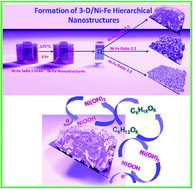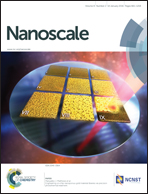Hierarchical 3-dimensional nickel–iron nanosheet arrays on carbon fiber paper as a novel electrode for non-enzymatic glucose sensing†
Abstract
Three-dimensional nickel–iron (3-D/Ni–Fe) nanostructures are exciting candidates for various applications because they produce more reaction-active sites than 1-D and 2-D nanostructured materials and exhibit attractive optical, electrical and catalytic properties. In this work, freestanding 3-D/Ni–Fe interconnected hierarchical nanosheets, hierarchical nanospheres, and porous nanospheres are directly grown on a flexible carbon fiber paper (CFP) substrate by a single-step hydrothermal process. Among the nanostructures, 3-D/Ni–Fe interconnected hierarchical nanosheets show excellent electrochemical properties because of its high conductivity, large specific active surface area, and mesopores on its walls (vide infra). The 3-D/Ni–Fe hierarchical nanosheet array modified CFP substrate is further explored as a novel electrode for electrochemical non-enzymatic glucose sensor application. The 3-D/Ni–Fe hierarchical nanosheet arrays exhibit significant catalytic activity towards the electrochemical oxidation of glucose, as compared to the 3-D/Ni–Fe hierarchical nanospheres, and porous nanospheres. The 3-D/Ni–Fe hierarchical nanosheet arrays can access a large amount of glucose molecules on their surface (mesopore walls) for an efficient electrocatalytic oxidation process. Moreover, 3-D/Ni–Fe hierarchical nanosheet arrays showed higher sensitivity (7.90 μA μM−1 cm−2) with wide linear glucose concentration ranging from 0.05 μM to 0.2 mM, and the low detection limit (LOD) of 0.031 μM (S/N = 3) is achieved by the amperometry method. Further, the 3-D/Ni–Fe hierarchical nanosheet array modified CFP electrode can be demonstrated to have excellent selectivity towards the detection of glucose in the presence of 500-fold excess of major important interferents. All these results indicate that 3-D/Ni–Fe hierarchical nanosheet arrays are promising candidates for non-enzymatic glucose sensing.


 Please wait while we load your content...
Please wait while we load your content...